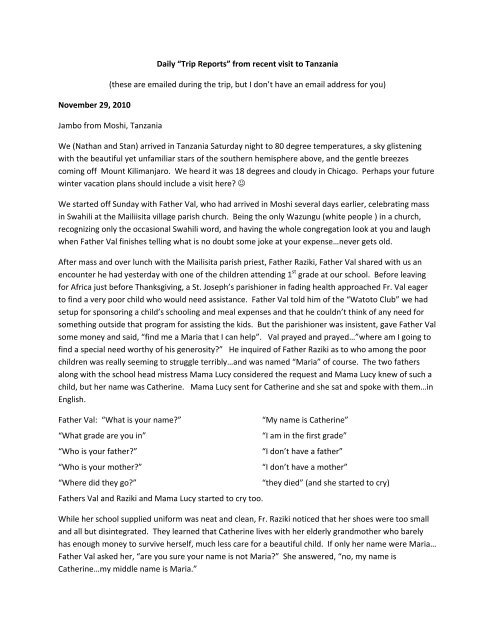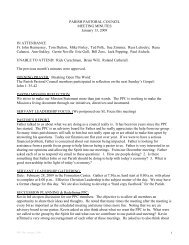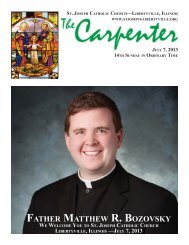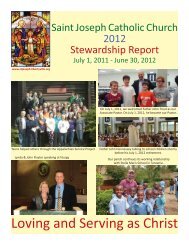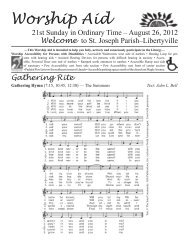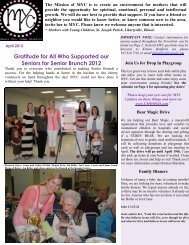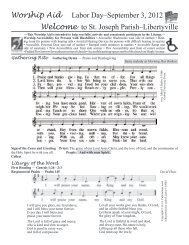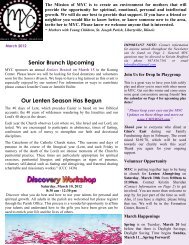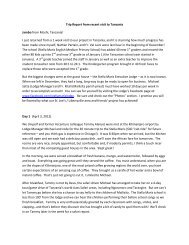2010-12 Trip Report - St. Joseph Parish
2010-12 Trip Report - St. Joseph Parish
2010-12 Trip Report - St. Joseph Parish
You also want an ePaper? Increase the reach of your titles
YUMPU automatically turns print PDFs into web optimized ePapers that Google loves.
November 29, <strong>2010</strong><br />
Daily “<strong>Trip</strong> <strong>Report</strong>s” from recent visit to Tanzania<br />
(these are emailed during the trip, but I don’t have an email address for you)<br />
Jambo from Moshi, Tanzania<br />
We (Nathan and <strong>St</strong>an) arrived in Tanzania Saturday night to 80 degree temperatures, a sky glistening<br />
with the beautiful yet unfamiliar stars of the southern hemisphere above, and the gentle breezes<br />
coming off Mount Kilimanjaro. We heard it was 18 degrees and cloudy in Chicago. Perhaps your future<br />
winter vacation plans should include a visit here? <br />
We started off Sunday with Father Val, who had arrived in Moshi several days earlier, celebrating mass<br />
in Swahili at the Mailiisita village parish church. Being the only Wazungu (white people ) in a church,<br />
recognizing only the occasional Swahili word, and having the whole congregation look at you and laugh<br />
when Father Val finishes telling what is no doubt some joke at your expense…never gets old.<br />
After mass and over lunch with the Mailisita parish priest, Father Raziki, Father Val shared with us an<br />
encounter he had yesterday with one of the children attending 1 st grade at our school. Before leaving<br />
for Africa just before Thanksgiving, a <strong>St</strong>. <strong>Joseph</strong>’s parishioner in fading health approached Fr. Val eager<br />
to find a very poor child who would need assistance. Father Val told him of the “Watoto Club” we had<br />
setup for sponsoring a child’s schooling and meal expenses and that he couldn’t think of any need for<br />
something outside that program for assisting the kids. But the parishioner was insistent, gave Father Val<br />
some money and said, “find me a Maria that I can help”. Val prayed and prayed…”where am I going to<br />
find a special need worthy of his generosity?” He inquired of Father Raziki as to who among the poor<br />
children was really seeming to struggle terribly…and was named “Maria” of course. The two fathers<br />
along with the school head mistress Mama Lucy considered the request and Mama Lucy knew of such a<br />
child, but her name was Catherine. Mama Lucy sent for Catherine and she sat and spoke with them…in<br />
English.<br />
Father Val: “What is your name?”<br />
“What grade are you in”<br />
“Who is your father?”<br />
“Who is your mother?”<br />
“My name is Catherine”<br />
“I am in the first grade”<br />
“I don’t have a father”<br />
“I don’t have a mother”<br />
“Where did they go?”<br />
“they died” (and she started to cry)<br />
Fathers Val and Raziki and Mama Lucy started to cry too.<br />
While her school supplied uniform was neat and clean, Fr. Raziki noticed that her shoes were too small<br />
and all but disintegrated. They learned that Catherine lives with her elderly grandmother who barely<br />
has enough money to survive herself, much less care for a beautiful child. If only her name were Maria…<br />
Father Val asked her, “are you sure your name is not Maria?” She answered, “no, my name is<br />
Catherine…my middle name is Maria.”
The children smile so much, it is easy to not see the pain they carry with them.<br />
We have a busy week of meetings ahead of us including: the architect and construction manager to<br />
discuss status and estimates to complete the project, a local furniture manufacturer to solicit his bid for<br />
making furniture for the guesthouse, Mama Lucy to discuss school progress and the budget for next<br />
year, the Bishop to thank him for his continued support, KCMC and Kibosho clinics to deliver medical<br />
supplies, and Fr. Kawishe and the Tanzanian NGO board we established for directing the project on an<br />
ongoing basis. Whew…I’m tired already!<br />
Kwaheri mpaka kesho,<br />
(goodbye until tomorrow)<br />
Nathan, <strong>St</strong>an & Father Val<br />
p.s., “watoto” is Swahili for “children”. The “Watoto Club” is the name we use to refer to people who<br />
are sponsoring children at the school. When completed, the guesthouse will earn enough money to pay<br />
for the children’s education and meals, but until then, the Watoto Club have been carrying the load.<br />
With 40 new 1 st graders getting ready to start school in January, there are many new opportunities for<br />
sponsorship!<br />
December 01, <strong>2010</strong><br />
Jambo from Moshi, Tanzania.<br />
The nearby town of Moshi is really starting to grow. Our project is in the outlying village of Mailisita. In<br />
Swahili, “Maili” means mile, and “sita” is six…so you can probably figure about how far from downtown<br />
Moshi we are . Our friend, Richard Torimo, the son of a local hotel owner, gave us a sneak peak tour<br />
of the tallest building in Moshi. It’s still under construction, but rises to an impressive nine stories. It<br />
even has a singing elevator! Why you would get into an elevator in an area where the electricity has<br />
gone out at least once each day we’ve been here is beyond me…so of course we rode in the tiny<br />
elevator to the top with our excited host. The view from the top was both amazing and enlightening.<br />
We had never been able to see more than the relatively dusty street in front of us in Moshi, but perched<br />
up nine stories it looked like a different world. There are so many trees throughout the town and the<br />
number of construction projects visible to us was impressive. Moshi is clearly an expanding city.<br />
Our host was understandably proud of Moshi’s accomplishments and its newest and tallest building.<br />
We boasted in return that our 3‐story guesthouse building is the tallest building under construction in all<br />
of Mailisita village…by a good two stories!<br />
Our first stop on Monday was to see how our 1 st graders are doing. They greeted us in a very orderly<br />
and mature fashion. They arranged themselves in three lines in front of the school and Catherine Calisti,<br />
first grader extraordinaire, led them in a medley of English language songs. Nathan thanked them and
asked one of the children in the front, “how are you?”. In answer, every child within earshot chanted in<br />
mantra‐lie unison, ““I…am…fine,…how…are…you?” Most of them will graduate this week and return as<br />
2 nd graders in January. They’ve come sooo far!<br />
Our second stop was over at the parish to see the Kindergarteners, and potential new batch of 1 st<br />
graders for January. Ahhh…now there’s the anarchy of being mobbed by children I remember from past<br />
years. Their enthusiasm for our arrival was not to be contained. Their teacher, Regina, did her best to<br />
bring them under control – and she can definitely command their respect. They too sang some songs<br />
for us and showed off their early English learning.<br />
Monday afternoon was spent in a Board of Directors meeting for the Mailisita Education Foundation of<br />
Tanzania. This is the Tanzanian registered NGO (non‐governmental organization) we established locally<br />
to direct the project and provide long‐term oversight to the school and guesthouse. The board is<br />
chaired by the Mailisita parish priest, formerly Father Kawishe (Father Val’s brother), and currently<br />
Father Riziki. The board discussed the school budget for the coming year, the hiring of an additional<br />
teacher for the 2 nd grade, and community feedback regarding school admissions decisions. Parents of<br />
some children in the parish were understandably disappointed when they learned there would not be<br />
enough room for their children, yet orphans from the village, but not the parish would be admitted.<br />
This was a very good discussion and test of their admissions philosophy which places need above<br />
religion or parish affiliation. The village of Mailisita is multicultural including Catholics, Lutherans,<br />
Muslims, and other religions, but the problems of poverty, AIDS, and a growing orphan population cut<br />
across these lines. Father Riziki and the NGO board affirmed the admissions decisions and reiterated<br />
their commitment to, “orphans of the village first, extremely poor second, and parishioner if space<br />
allows”.<br />
We closed out the day with an outdoor dinner of local cuisine and enjoyed the views of Mount<br />
Kilimanjaro. Tomorrow we will tour the guesthouse and inspect the work completed since our last visit.<br />
We have dinner plans with our friend Fr. Maningi at his nearby Karanga technical school.<br />
Kwaheri mpaka kesho,<br />
Nathan, <strong>St</strong>an & Father Val<br />
December 2, <strong>2010</strong><br />
Jambo from Moshi, Tanzania<br />
We started the day with an inspection tour of the work in progress on the guesthouse. Aloysius, the<br />
“fundi” (Swahili for foreman, or boss man) was our guide and Father Val our translator. The ground<br />
floor is now completely finished and ready to receive furniture and kitchen equipment. The ground<br />
floor is made up of a reception area, kitchen, restrooms, room for an Internet café, and a large hall that<br />
can be divided for dining and hosting of meetings and events such as conferences or even weddings. It is<br />
a truly beautiful building interior and locals who have seen it have reacted, “ooh…you are going to make
lots of money”. That is of course the whole idea ‐‐ so that they will be able to fund the school<br />
themselves going forward.<br />
The tour continued to the 2 nd floor where at least a dozen workers (more than usual) were busy at work.<br />
The guestroom floor is divided into fourteen guest rooms, each with a private bathroom and balcony.<br />
The “high rent” side has uninterrupted views of Kilimanjaro. Last July’s visitors/crew from the U.S.,<br />
especially the eleven strong backs of the college students from Holy Cross under the direction of Matt<br />
Partain, had completed most of the cement block dividing walls that define the rooms. The visible<br />
progress in the intervening four months was a little disappointing. The doors and windows were<br />
framed, but not yet installed and the crew was currently running plumbing piping and finishing<br />
plastering of the walls. Aloysius confidently promises that the guestrooms will be complete (except for<br />
the flooring) by Christmas…right on schedule. Given the number of workers on site and activity level we<br />
see today, that should be very doable.<br />
We mentioned yesterday the large number of new construction projects in Moshi we could see from<br />
atop their new tallest building. One might suspect (including the three of us) that our laborers were<br />
perhaps working on another job for some part of the past few months! As anyone who has suffered the<br />
project of building a house will know, yep, that happens. Demand for experienced construction crews is<br />
no doubt starting to materialize and we are of course not the top Schilling payer. Our visit today is<br />
serving as an important reminder that we have a schedule to meet – the guesthouse must be ready to<br />
open by November of next year.<br />
After our tour, we met with the school headmistress, Mama Shayo to review student performance and<br />
talk about the coming year. Mama Shayo reviewed her grade book with us and the marks told an<br />
interesting story. Most of the 44 students were receiving As, Bs, and Cs, but ten or so consistently had<br />
marks of Ds and Fs (actually they use the more common sense letter of ‘E’). Mama Shayo told of the<br />
extra efforts of her and the other teacher to work after school and over holidays with roughly 15<br />
children who were struggling much more than the others. Through their efforts, six of them improved<br />
their marks enough to progress to the 2 nd grade, but it was determined that nine of them are simply not<br />
ready and will need to repeat 1 st grade. In their culture, they do not just pass a struggling student along<br />
for the next teacher to deal with, but address it directly.<br />
After our meeting, <strong>St</strong>an made the mistake of lingering outside the classroom to take some pictures a bit<br />
longer than the other two. Mama Shayo, looking like she had just remembered something very<br />
important, rushed out of the classroom and said, “Mr. Taylor, Mr. Taylor…one of the toilets is broken”<br />
and proceeded to walk him toward the school bathrooms. Hoping it was simply a mistranslation, <strong>St</strong>an<br />
skeptically accompanied her. Nope, Mama Shayo knows her English quite well – stall #3 was roped off.<br />
You really feel accepted as one of the village when asked to fix a toilet. (post note: a quick trip to the<br />
hardware store (street vendor stall actually) to find a replacement hose fitting and <strong>St</strong>an had the toilet<br />
working in no time).<br />
Kwaheri mpaka kesho,
Nathan, Plumber <strong>St</strong>an & Father Val<br />
December 4, <strong>2010</strong><br />
Jambo and kwaheri (goodbye) from Moshi, Tanzania<br />
The three of us are actually back state‐side by now, having endured a 32 hour door‐to‐door return<br />
journey owing to snow‐driven airport closures and delays in Europe. Our final couple of days were busy<br />
and the pieces really fell into place nicely for how the project will progress until we can return and cause<br />
trouble again. Here’s a recap of some of the highlights.<br />
On Tuesday afternoon we met with Bishop Amani to thank him for his support of the project. Paying a<br />
call on the Bishop has become a regular itinerary item in recent years. Many of our key contacts,<br />
supporters and experts on a surprisingly wide variety of topics are Catholic priests who work under the<br />
direction of the Bishop. It amazes us how throughout the project just the right priest with just the right<br />
knowledge, skills and contacts makes himself available to work with us at just the right moment.<br />
Coincidences? Maybe, but we think we’ll keep visits to the Bishop on our future itineraries all the same.<br />
Wednesday afternoon we visited Father Kawishe (Father Val’s brother) in Korongoni where he is staying<br />
while continuing his recuperation and rehabilitation from back surgery. In addition to catching up, as<br />
shepherds of your donations, we reviewed project receipts, estimates for upcoming construction tasks,<br />
and discussed key decisions and priorities. It was good to see our friend, project visionary and chief<br />
accountant, in good health and gaining strength.<br />
Wednesday evening was a chance to have dinner with Mike Mosha, the architect and all around<br />
knowledgeable guy when it comes to construction in the area. Mr. Mosha is important to us as our chief<br />
estimator and provides guidance on how much the remaining steps to finish the project will cost and<br />
how long they will take to complete. With enough classrooms completed to see us through 20<strong>12</strong>, the<br />
focus of construction has been on the Guesthouse – the economic engine that once completed will<br />
make the project self‐sustaining. He feels confident that the guestroom floor plumbing, electrical, wall<br />
finishes and ceilings will be completed by Christmas and the tile floors laid in January. This would put us<br />
a little ahead of our original schedule and well positioned to begin furnishing and decorating in time for<br />
opening later that year.<br />
It’s kind of like building a house in that there are many decisions and tradeoffs to be made with respect<br />
to schedule, cost, and finishings (e.g., tile vs. cement floors, window sizes, door hardware quality and so<br />
on). The philosophy we apply to such decisions is simple: spend the least amount we can spend while<br />
still ensuring that our quality level and amenities are comparable to guesthouses in the area where<br />
visitors willingly pay the room rate necessary to earn the income we need to run our school…well, I<br />
guess it looks a little more complicated when you type it all out, but as long as we keep that rule in<br />
mind, the answers usually become pretty obvious.<br />
Father Maningi was our host for dinner at the Karanga Technical and Training Centre. This is where<br />
interns Alex Causey and Terry Mulligan stayed while working with the children in the school this past
year. As part of his many responsibilities, Father Maningi runs this vocational training center where<br />
young artisans learn furniture making skills. It was his shop that produced the excellent, yet affordable<br />
desks our school is fortunate to have. In advance of our dinner, Father was kind enough to visit several<br />
guesthouses in the area to see typical furnishings and styles and also to send someone to the local<br />
market to price items such as plates, linens, glasses, kitchen appliances, etc. ‐‐ all the things we need to<br />
setup shop. The information was invaluable in helping us refine our budget expectations and think<br />
through if we should consider importing any class of item (e.g., linens or small appliances) in order to<br />
save money or improve quality. To be even more helpful, Father Maningi has directed his shop to<br />
manufacture sample furniture pieces to see how well they fit and look in our soon to be completed<br />
guestrooms.<br />
Friday was the last day of the school year for the Kindergarten program. By coincidence of us being here<br />
last year for “graduation”, it has now become somewhat of a tradition that we spring for a special meal<br />
of rice and beef (called “Pilau”) for the children…a tab the three of us were happy to pick up. Just as last<br />
year, most of the children came to school Friday with a plate they brought from home for this rare treat.<br />
We learned that last year many of the children felt poorly after the feast as their digestive systems are<br />
simply not used to such a meal. Even rice is a rarity in many of their diets, much less beef. For the<br />
children who had no plates, the teacher put out a large circular platter on the floor for the ten or so of<br />
them to share from. Expecting a free‐for‐all at the least, we setup cameras to catch what we were sure<br />
would be the ensuing mayhem. But after a prayer of thanksgiving, the children slowly, carefully and<br />
silently shared their meal being sure not to drop even a grain of rice. Try that in a classroom here!<br />
After Pilau‐fest <strong>2010</strong> was over, it was time to say goodbye and start our trek to the airport. During these<br />
hellos and goodbyes, you get a real sense for how important our collective efforts are to these poor<br />
children on the flipside of our planet. They are so eager to hold your hand that you have to spread your<br />
fingers out so ten children can hold onto you instead of just two. One of our school’s 1 st grade girls who<br />
came for the festivities said in perfectly clear English, “I am sad. I don’t want you to go home.”<br />
As ambassadors for you, the donors, we accepted on your behalf the thanks of the bishop, the priests,<br />
the teachers, the cooks, the builders, the night watchman, the parish, the village, and most especially,<br />
the children of Mailisita. There is no way to adequately distil and express back to you the magnitude<br />
and sincerity of their very genuine gratitude.<br />
Thank you and God Bless<br />
(Asante sana na Mungu akubariki)<br />
Nathan, <strong>St</strong>an & Father Val<br />
P.S. remember the Mailisita Foundation (www.mailisita.org) if you need help lessening your tax burden this coming<br />
season


